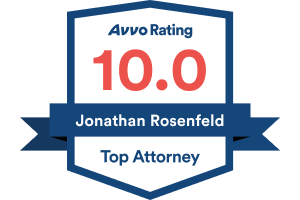- 24/7 Free Consultation: (888) 424-5757 Tap Here To Call Us
Wrongful Death Statute of Limitations by State

Understanding the statute of limitations for wrongful death lawsuits is crucial, as it varies from state to state. This legal timeframe determines how long surviving family members have to file a wrongful death lawsuit following a loved one’s death due to negligence or wrongful actions.
Navigating these timelines can be complex, and missing the deadline may jeopardize your opportunity for compensation.
At Rosenfeld Injury Lawyers, we understand how hard this time is for you and your family. While no amount of money can ever replace what you’ve lost, you shouldn’t have to deal with the financial burdens alone during this difficult period.
Our experienced wrongful death lawyers are dedicated to providing you with essential information based on state law so that you can pursue justice for your loved one.

What Is a Wrongful Death Lawsuit?
A wrongful death lawsuit is a legal action taken when an individual dies as a result of the negligent or wrongful conduct of another party. The primary purpose of such a lawsuit is to compensate the deceased’s survivors for their loss and associated damages.
This type of legal claim aims to hold the at-fault party accountable for their actions, ensuring that justice is served and appropriate financial restitution is provided to the suffering family members.
To establish a wrongful death claim, the following elements must typically be demonstrated:
- Death of an individual
- Wrongful actions of another party
- Resulting damages
Examples of Situations Where a Wrongful Death Lawsuit May Be Applicable
Various circumstances can give rise to a wrongful death lawsuit, reflecting the diverse nature of negligence and misconduct that can result in tragic fatalities. Common situations include:
Car Accident
In cases where a person’s negligence results in a car accident and a fatal injury, the victim’s family may pursue a wrongful death lawsuit against the at-fault driver. This includes scenarios such as drunk driving, reckless driving, or failure to obey traffic signals.
Medical Malpractice
If a healthcare professional’s negligence—such as misdiagnosis or surgical errors—leads to the death of a patient, loved ones, or the deceased’s estate can file a wrongful death claim against the medical provider for this wrongful act.
Workplace Accidents
In situations where an employee’s death occurs due to unsafe working conditions, such as lack of proper safety equipment or training, the family may have grounds for a wrongful death lawsuit against the employer.
Defective Products
When a consumer product malfunctions and causes a fatal personal injury, the manufacturer may be liable for wrongful death. Examples include auto accidents caused by defective brakes or food poisoning from contaminated products.
What Is a Statute of Limitations?
A statute of limitations is a legal provision that establishes a specific time frame within which plaintiffs can take legal action. In wrongful death lawsuits, this time frame is critical as it dictates the period available for the victim’s family to seek justice and compensation for their loss. Most states set this deadline between one and three years.
Typically, the statute of limitations for a wrongful death lawsuit begins on the date of the deceased individual’s death. Missing this deadline can result in the forfeiture of the right to pursue any legal action, making it important to consult with legal professionals as soon as possible after the loss of a loved one.
Wrongful Death Statute of Limitations by State
The statute of limitations for wrongful death claims can vary significantly across different states. Understanding these time frames is essential for families seeking justice, as each state sets its own deadline within which a lawsuit must be initiated.
Below are the wrongful death statutes of limitations by state.
| State | Deadline | Damage Caps | Code | Discovery Rule | Exceptions |
|---|---|---|---|---|---|
| Alabama | 2 years | None | Ala. Code § 6-5-410 | ||
| Alaska | 2 years | Non-economic damages are capped at either $400,000 or the deceased’s life expectancy multiplied by $8,000, whichever amount is greater. In most cases, punitive damages are limited to the greater of three times the compensatory damages awarded or $500,000. | Alaska Stat. § 09.55.580 | If the discovery of fault or the cause of injuries or fault is delayed despite reasonable efforts, the statute of limitations may not begin until the date of discovery. | Minor Beneficiaries: The statute of limitations may be tolled duruing the period in which the statutory beneficiaries are minors. |
| Arizona | 2 years | Punitive damages are capped at 3 times the amount of pecuniary damages awarded or $2 million, whichever is greater. | Ariz. Rev. Stat. § 12-542 | The statute of limitations begins when the plaintiff discovers, or reasonably should have discovered, that they death wa caused by the defendant’s negligent conduct. | |
| Arkansas | 3 years | None | Ark. Code § 16-62-102 | Medical Malpractice: 2 years for deaths related to medical malpractice. Homicide: Statute of limitations is the same as the criminal offense statute of limitations. | |
| California | 2 years | For medical malpractice cases involving wrongful death, the noneconomic damages cap for 2024 is set at $550,000, with planned increases each year until it reaches $1 million in 2033, after which it will be adjusted annually for inflation. | Cal. Code Civ. Proc. § 335.1 | The statute of limitations begins when the cause of the individual’s death is discovered or reasonably should have been discovered through diligence and investigation. | Minor Beneficiaries: Statute of limitations is 2 years from their 18th birthday. Medical Malpractice: A claim must be filed within 1 year from discovering the death was caused by medical negligence or 3 years from the date of death, whichever comes first. Government Entity: 6 months to file. |
| Colorado | 2 years | None-economic damages capped at $2,125,000. For deaths resulting from malpractice, the cap will incrementally increase to $1,575,000 over the next five years from the previous $300,000, with adjustments every two 2 for inflation. | Colo. Rev. Stat. § 13-80-102 | Hit-and-Run Homicide: Statute of limitations is 4 years. Concealment: If defendant hides facts, the claim can be filed upon discovery of the facts. | |
| Connecticut | 2 years | None | Conn. Gen. Stat. § 52-555 | The statute of limitations begins when the cause of the individual’s death is discovered or reasonably should have been discovered through diligence and investigation but no later than 5 years after the date of the act. | Homicide: In a homicide or manslaughter case, a wrongful death lawsuit can be filed at any time after the act if the defendant is found guilty or not guilty by reason of insanity. |
| Delaware | 2 years | None | Del. Code tit. 10 § 8107 | The statute of limitations begins when the cause of the individual’s death is discovered or reasonably should have been discovered through diligence and investigation. | |
| Florida | 2 years | Punitive damages are capped at 3 times the value of the compensatory damages (both economic and noneconomic) awarded to each claimant or $500,000. | Fla. Stat. § 95.11 | Homicide: In a homicide case, the wrongful death claim can be filed at any time. | |
| Georgia | 2 years | $250,000 cap on punitive damages. | Ga. Code § 9-3-33 | ||
| Hawaii | 2 years | $375,000 for non-economic damages in most cases. | Haw. Rev. Stat. § 663-3 | The courts haven’t ruled on this matter, but the discovery rule likely applies to wrongful death claims because the wrongful death and personal injury statute are the same. | |
| Idaho | 2 years | Non-economic damages capped at $250,000, but adjusts annually for inflation and average annual wages, amounting to $458,728.65 as of 2023. | Idaho Code § 5-219 | Concealment: If defendant hides facts, the claim can be filed upon discovery of the facts. | |
| Illinois | 2 years | None | 740 ILCS 180/2 | The statute of limitations begins when the cause of the individual’s death is discovered or reasonably should have been discovered through diligence. | Violent Crimes: An action may be brought within 5 years of the death if it resulted from violent intentional conduct, or within one year after the final disposition of the criminal case if the defendant is charged with first-degree murder, homicide of an unborn child, second-degree murder, manslaughter, reckless homicide, or drug-induced homicide. Beneficiaries Under 18: The statute of limitations begins when the minor turns 18. |
| Indiana | 2 years | Damages for unmarried adults 23 and older without dependents are capped at $300,000, including medical and funeral expenses; there are no caps for married adults or those with dependents; no caps apply to the death of a child; medical malpractice wrongful deaths have a cap of $1,800,000; and deaths due to government negligence are capped at $700,000. Punitive damages are capped at either 3 times the amount of compensatory damages awarded or $50,000, whichever is higher | Ind. Code § 34-23-1-1 | ||
| Iowa | 2 years | None | Iowa Code § 614.1 | The discovery rule allows the statute of limitations to start when you discover or reasonably should have discovered that there is a cause of action. | |
| Kansas | 2 years | Non-economic damages are capped at $250,000, punitive damages are capped at the greater of the defendant’s highest annual gross income over the past five years, up to 50% of the defendant’s net worth if deemed necessary by the court, or $5 million. | Kan. Stat. § 60-513 | The discovery rule allows the statute of limitations to start at the time a negligent act causes injury if both the act and the resulting injury are reasonably ascertainable by the injured person. | |
| Kentucky | 1 year after qualification of personal representative | None | Ky. Rev. Stat. § 413.180 | Fradulent Concealment: In cases where the cause of death is fraudulently concealed, the statute of limitations does not run until the date of discovery. | |
| Louisiana | 1 year | None | La. Civ. Code art. 2315.2 | ||
| Maine | 3 years | Non-economic damages are capped at $1,000,000 – adjusted for inflation, punitive damages capped at $500,000. | Me. Stat. tit. 18-C § 2-807 | Homicide: When death is caused by homicide, statute of limitations is 6 years | |
| Maryland | 3 years | If 1 beneficiary, non-economic damages are capped at $935,000. If 2 beneficiaries, they aer capped at $1,402,500. | Md. Code, Cts. & Jud. Proc. § 3-904 | Occupational Diseases: Within 10 years of death or 3 years of discover, whichever is shorter. Malpractice: When death is caused by malpractice, statute of limitations starts when cause of death is discovered, but claim cannot be filed more than 5 years from the date of death. Homicide: If knowledge of a cause of action or the identity of a person responsible for a homicide is concealed by the adverse party or their accomplice, the cause of action is considered to begin when the party discovers, or should have discovered through ordinary diligence, the homicide and the responsible person’s identity. | |
| Massachusetts | 3 years | None | Mass. Gen. Laws ch. 229 § 2 | The discovery rule allows the statute of limitations to start when you discover or reasonably should have discovered that there is a cause of action. | |
| Michigan | 3 years | None | Mich. Comp. Laws § 600.5805 | ||
| Minnesota | 3 years | None | Minn. Stat. § 573.02 | Fradulent Concealment: In cases where the cause of death is fraudulently concealed, the statute of limitations does not run until the date of discovery. Murder: A lawsuit seeking damages for a death caused by an intentional act of murder can be filed at any time after the decedent’s death, without time limitations. | |
| Mississippi | 3 years | Non-economic damages are capped at $1 million, punitive damages are generally capped based on the defendant’s net worth. | Miss. Code § 15-1-49 | Latent Injury: In cases where no specific time limit is set and the injury or disease is latent, the statute of limitations begins when the plaintiff discovers, or reasonably should have discovered, the injury. | |
| Missouri | 3 years | None | Mo. Rev. Stat. § 537.100 | Fradulent Concealment: In cases where the cause of death is fraudulently concealed, the statute of limitations does not run until the date of discovery. | |
| Montana | 3 years | Punitive damages are capped at $10 million or 3% of a defendant’s net worth, whichever is less. | Mont. Code § 27-2-204 | Homicide: When death is caused by homicide, statute of limitations is 10 years. | |
| Nebraska | 2 years | None | Neb. Rev. Stat. §§ 30-810 | Fradulent Concealment: In cases where the cause of death is fraudulently concealed, the statute of limitations does not run until the date of discovery. | |
| Nevada | 2 years | Punitive damages are capped at $300,000 if compensatory damages are less than $100,000, but if compensatory damages are $100,000 or more, the cap increases to three times the amount of compensatory damages. | Nev. Rev. Stat. § 11.190 | Medical Malpractice: Statute of limitations begins on the date of discovery. | |
| New Hampshire | 3 years | Effective January 1, 2025, non-economic damages caps in wrongful death cases will increase from $150,000 to $500,000, and caps on wrongful death claims involving a minor decedent will rise from $50,000 to $300,000 per individual claimant. | N.H. Rev. Stat. § 508:4 | The discovery rule allows the statute of limitations to start when you discover or reasonably should have discovered the cause of action. | |
| New Jersey | 2 years | None, punitive damages cannot be recovered | N.J. Stat. § 2A:15-3 | Murder: In cases of murder, aggravated manslaughter, or manslaughter where the defendant is convicted, found not guilty by reason of insanity, or adjudicated delinquent, a legal action may be brought at any time without time limitations. | |
| New Mexico | 3 years | None | N.M. Stat. § 41-2-2 | ||
| New York | 2 years | None | N.Y. EPTL 5-4.1 | Criminal Case: If a criminal case is started against the same defendant related to the event causing the claim, the decedent’s personal representative has at least 1 year after the criminal case ends to file a lawsuit, even if the original time limit has expired or less than a year remains. | |
| North Carolina | 2 years | In most wrongful death cases, punitive damages are capped at $250,000 or 3 times the total of their claimed economic damages | N.C. Gen. Stat. § 1-53 | Malpractice: When death is caused by malpractice, statute of limitations starts when cause of death is discovered, but claim cannot be filed more than 4 years from the date of death. | |
| North Dakota | 2 years | None | N.D. Cent. Code § 28-01-18 | Malpractice: When death is caused by malpractice, statute of limitations starts when cause of death is discovered, but claim cannot be filed more than 6 years from the date of death unless discovery of the cause of death was fraudulently concealed by the physician or hospital. | |
| Ohio | 2 years | None | Ohio Rev. Code § 2125.02 | The discovery rule allows the statute of limitations to start when you discover or reasonably should have discovered the cause of action. | |
| Oklahoma | 2 years | Punitive damages are categorized into three levels: Category I caps at the greater of $100,000 or actual damages for reckless disregard; Category II at the greater of $500,000, twice the actual damages, or the financial benefit derived for intentional and malicious acts; and Category III, involving conduct that is life-threatening to humans, has no cap. | Okla. Stat. tit. 12 § 1053 | ||
| Oregon | 3 years | Non-economic damages are capped at $500,000 | ORS § 30.020 | The discovery rule allows the statute of limitations to start when you discover or reasonably should have discovered the cause of action. | |
| Pennsylvania | 2 years | Punitive damages are capped at 200% of the compensatory damages awarded | 42 Pa. C.S. § 5524 | Asbestos Exposure: A lawsuit for injury or death caused by asbestos exposure must be filed within 2 years from the date a licensed physician informs the person of the asbestos-related injury, or the date the person knew or should have known about the injury, whichever comes first. | |
| Rhode Island | 3 years | None | R.I. Gen. Laws § 10-7-2 | The discovery rule allows the claim to be filed within 3 years from the date that the wrongful act, neglect, or default is discovered or, in the exercise of reasonable diligence, should have been discovered | |
| South Carolina | 3 years | Punitive damages are capped at the greater of 3 times the compensatory damages awarded to each claimant or $500,000. | S.C. Code § 15-3-530 | ||
| South Dakota | 3 years | None | S.D. Codified Laws § 21-5-3 | ||
| Tennessee | 1 year | In most cases, non-economic damages are capped at $750,000, but this cap increases to $1,000,000 for catastrophic injuries; punitive damages are limited to the greater of 2 times compensatory damages or $500,000. | Tenn. Code § 28-3-104 | The discovery rule allows the statute of limitations to start when you discover or reasonably should have discovered the cause of action. | |
| Texas | 2 years | Punitive damages are capped at the greater of 2x economic damages plus non-economic damages found by the jury (not to exceed $750,000) or, $200,000 | Tex. Civ. Prac. & Rem. Code § 16.003 | ||
| Utah | 2 years | None | Utah Code § 78B-2-304 | The discovery rule is applicable in some cases. | |
| Vermont | 2 years | None | Vt. Stat. tit. 14 § 1492 | Statute of limitations is 2 years from the discovery of the death. | Homicide: If a death leads to probable cause for a homicide charge, a legal action must be filed within 7 years of discovering the death or within 2 years after the criminal judgment becomes final, whichever is later. Defendant Out of State: If the person against whom the action is filed is out of the state, the lawsuit can be started within two years of their return, and any time they are absent from the state and have no attachable property there will not count toward the time limit for filing the action. |
| Virginia | 2 years | Punitive damages are capped at $350,000 | Va. Code § 8.01-244 | ||
| Washington | 3 years | None | Wash. Rev. Code § 4.16.080 | The discovery rule allows the statute of limitations to start when you discover or reasonably should have discovered the cause of action. | |
| Washington, D.C. | 2 years | None | D.C. Code § 16-2702 | Fradulent Concealment: In cases where the cause of death is fraudulently concealed, the statute of limitations does not run until the date of discovery. | |
| West Virginia | 2 years | The cap for punitive damages is set at four times the amount of compensatory damages awarded or $500,000, whichever is greater. | W. Va. Code § 55-7-6 | The statute of limitations begins when the decedent’s representative knows, or reasonably should know, of the death, that it was caused by wrongful action or neglect, the responsible party’s identity, and the connection between the wrongful act and the death. | |
| Wisconsin | 3 years | Non-economic damages are capped at $500,000 per occurrence in the case of a deceased minor, or $350,000 per occurrence in the case of a deceased adult. Punitive damages are capped at the greater of twice the compensatory damages or $200,000, except this cap does not apply in cases involving drunk driving. | Wis. Stat. § 893.54 | The claim accrues on the date the wrongful death beneficiary discovers, or reasonably should have discovered, the injury. | |
| Wyoming | 2 years | None | Wyo. Stat. § 1-38-102 |
Exceptions and Extensions
While the statute of limitations for wrongful death claims typically sets a strict deadline for filing lawsuits, several exceptions and circumstances may affect this timeframe. Understanding these exceptions is essential for families seeking justice, as they can allow for additional time to file a wrongful death lawsuit when certain conditions are met.
The Discovery Rule
The discovery rule is a critical exception to the wrongful death statute of limitations in cases where the cause of death is not immediately apparent. This rule allows for the statute of limitations for wrongful death to be extended from the date of death to the date when the family becomes aware, or reasonably should have become aware, of the cause of death.
For instance, if a loved one’s death is attributed to a medical issue that was not diagnosed at the time, the family may have additional time to file a wrongful death claim.
Wrongful Death Cases Involving Product Defects
In cases involving product defects, the statute of limitations for wrongful death may also be subject to extensions. Typically, the state’s statute of limitations period starts on the date of the individual’s death.
However, if a defective product is the cause of death and this defect was not known at that time, the limitations period to file a wrongful death lawsuit may begin from the date the defect was discovered.
Families must provide substantive evidence in court to justify this extension, demonstrating the timeline of their knowledge regarding the defect and its connection to the death.
Medical Malpractice Wrongful Deaths
Medical malpractice wrongful death cases occur when a death is attributed to the negligence of a healthcare professional or facility. In these instances, the wrongful death statute of limitations typically begins from the date of the individual’s death, but certain factors, such as the discovery of the malpractice, may influence the timeline.
Families must establish a direct correlation between the alleged malpractice and the person’s death, often requiring expert testimony to support their claims. Understanding these nuances is critical for families seeking justice and compensation for their loss.
Occupational Diseases
In some cases, exceptions involving occupational diseases may afford additional time for filing claims, particularly if the death was not immediately associated with the conditions that led to the illness.
If a person’s wrongful death occurs due to an occupational disease, the personal representative or loved ones of the deceased may file a valid wrongful death claim under applicable wrongful death laws.
It is essential for a wrongful death attorney to establish that the victim’s death was a direct result of their exposure to hazardous conditions or substances in the workplace.
Certain Criminal Offenses
A wrongful death action related to certain criminal offenses may also warrant exceptions to the typical statute of limitations for wrongful death. For example, if a death results from violent intentional conduct like criminal homicide, some jurisdictions may allow an extension of the applicable statute to file a wrongful death suit until the criminal case is fully resolved.
This recognition ensures that families of the deceased person are not disadvantaged in pursuing justice while dealing with the legal process in criminal court.
Filing a Wrongful Death Claim
Filing a wrongful death suit is a crucial step for families seeking justice and compensation for the loss of a loved one due to another’s negligence or wrongful act. Understanding who is eligible and how this process works is important so plaintiffs know what to expect after a death occurs.
Eligible Parties
In most jurisdictions, the right to file a wrongful death lawsuit is typically reserved for close family members of the deceased, which can include the decedent’s surviving spouse, children, and parents.
However, eligibility to file varies by state, with some allowing extended family members or dependents to initiate legal action. It’s essential to consult the specific laws in your state to determine who qualifies as an eligible party.
In many cases, a personal representative of the deceased’s estate, often appointed through the probate process, is required to file the wrongful death suit. This personal representative acts on behalf of the estate and any eligible beneficiaries, ensuring that all parties have the opportunity to seek compensation for their loss.
The personal representative is responsible for filing the necessary paperwork and representing the interests of the deceased’s estate and loved ones in court.
Proving Cause and Liability
In a wrongful death lawsuit, establishing cause and liability is crucial for the case’s success. Merely asserting that an individual or entity caused the victim’s death is insufficient; it is essential to present compelling evidence that clearly demonstrates how negligence or wrongful act directly resulted in the loss of life.
To file a successful wrongful death claim, it is necessary to prove that the defendant’s actions fell below the reasonable standard of care expected in similar situations. This involves demonstrating that the defendant acted recklessly or failed to take appropriate measures to prevent harm.
For example, all drivers on the road have a duty to drive safely and not injure others around them. If a driver breaches this duty and causes the death of a loved one, you may have a wrongful death claim.
The plaintiff must then illustrate a direct link between the defendant’s conduct and the person’s death. This connection must convey that if the defendant had acted differently, the deceased would likely still be alive.
An established cause and liability allow families to receive compensation for their losses, including economic damages like medical expenses and lost income, as well as non-economic damages such as pain and suffering.
Types of Evidence Necessary
To effectively prove causation and liability, various forms of evidence should be collected, including:
- Photographs and Video Evidence: Visual documentation can illustrate the conditions surrounding the incident, offering compelling evidence of negligence or misconduct.
- Medical Records: Documentation that shows the deceased’s injuries and the treatment received, providing insight into the medical cause of death.
- Expert Testimony: Opinions from medical professionals or accident reconstruction experts can substantiate claims regarding the cause of death and clarify whether the defendant’s actions were negligent.
- Accident Reports: Official reports from law enforcement or regulatory bodies can provide essential information regarding the circumstances leading to the death.
- Witness Statements: Eyewitness accounts can help corroborate the sequence of events and the actions of the parties involved.
Challenges in Establishing Causation and Damages
Establishing causation and damages in wrongful death cases presents significant challenges that require careful navigation. Some common difficulties include:
- Complexity of Events: Proving that specific actions directly led to the death can be complicated, particularly in cases involving multiple parties or situations where external factors contributed to the incident.
- Disputes Over Liability: Defendants often contest their level of responsibility, necessitating a thorough examination of the facts and potential opposing narratives.
- Quantifying Damages: Accurately assessing the emotional and financial impact of the loss on the surviving family members can present further challenges, as it often requires expert evaluations and legal knowledge.
Navigating these cases without legal support can lead to mistakes being made that may jeopardize your chance to seek justice and compensation for your loss. It is crucial to engage with a law firm that specializes in these types of cases, such as Rosenfeld Injury Lawyers, to ensure that your case is handled appropriately.
Potential Compensation
In wrongful death cases, compensatory damages are awarded to help alleviate the financial burden brought on by the loss and to provide support to the surviving family members. These damages can encompass both monetary and non-monetary losses and most often include:
- Funeral and Burial Expenses: Costs associated with burial or cremation, including memorial services and related expenses.
- Medical Bills: Prior medical expenses incurred before the death as a result of the incident, such as hospital stays, surgeries, and therapies.
- Lost Wages: Compensation for the deceased’s lost income, which includes projected future earnings based on current income levels and career longevity.
- Loss of Companionship: Compensation for the emotional anguish experienced by close family members due to their loved one’s death.
- Pain and Suffering: Recognizes the physical pain and mental suffering endured by the deceased before passing away, as well as the pain felt by the survivors.
- Punitive damages: In some cases, the court may award punitive damages to punish the negligent party for their egregious actions and deter similar behavior in the future. For example, these may be applicable in cases of a hit-and-run accident, intentional violence, or situations involving a deceased child.
Factors Affecting Compensation
The amount of compensation awarded in a wrongful death suit can vary significantly based on a number of factors, including:
- Extent of Damages: The overall financial and emotional toll taken on the survivors, including the severity of economic losses and the emotional impact of the loss.
- State Laws: Different jurisdictions have varying statutes that govern wrongful death proceedings, including caps on non-economic damages and specific eligibility criteria.
- Evidence Presented: The strength and clarity of the evidence supporting the claim can drastically affect outcomes, as compelling evidence enhances the likelihood of a higher award.
- Negligence and Liability: The degree of fault assigned to the at-fault party may influence the compensation amount, particularly in comparative fault states where damages can be reduced based on the plaintiff’s level of liability.
Understanding these factors is crucial for navigating the complexities of wrongful death claims and ensuring that the compensation awarded reflects the true impact of the loss experienced.
Hiring a Wrongful Death Attorney
Working with a wrongful death attorney is a critical step in the pursuit of justice and compensation following the tragic loss of a loved one. It is imperative to take timely action in filing a wrongful death claim, as each state imposes statute of limitations laws that dictate how long you have to initiate legal proceedings.
Failing to act within this timeframe can result in the forfeiture of your right to seek compensation, leaving survivors without recourse for their substantial losses.
A wrongful death lawyer from Rosenfeld Injury Lawyers understands the intricacies of a personal injury and wrongful death case. We provide comprehensive legal support, ensuring that all pertinent evidence is collected and presented effectively.
Your Next Steps
It is essential to consult with a wrongful death attorney promptly to ensure that your wrongful death claim is filed within the required timeframe. The complexity of these cases, coupled with the emotional burden of loss, makes professional legal assistance invaluable.

An experienced attorney from Rosenfeld Injury Lawyers can help you navigate the intricacies of state laws, manage necessary documentation, and strengthen your case to maximize your chances of a successful outcome.
Don’t delay in seeking the support you need. Act now to protect your rights and secure the compensation you deserve. Speak with a wrongful death attorney today by calling us at (888) 424-5757 or complete our online contact form.
All content undergoes thorough legal review by experienced attorneys, including Jonathan Rosenfeld. With 25 years of experience in personal injury law and over 100 years of combined legal expertise within our team, we ensure that every article is legally accurate, compliant, and reflects current legal standards.







